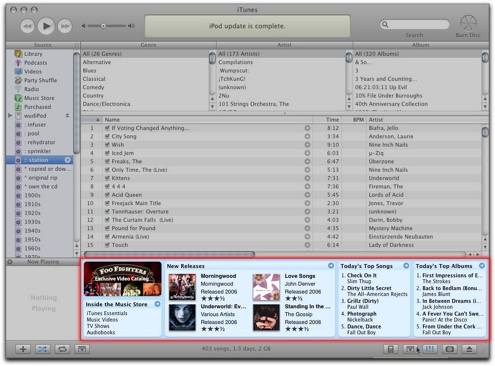As part of an effort to streamline things while I’m in school, I’ve been working here and there on paring down the number of newsfeeds I subscribe to. One of the steps I took a couple weeks ago was removing the majority of my mac-specific site feeds (Macintouch, MacFixit, and various others), figuring that if any big news broke, chances are good that I’d hear about it from plenty of other places.
Boy was I right on that assumption. I can’t count the number of different places I’ve seen mention Boot Camp, and I’m only up to around noon yesterday in my newsreading. Crazy.
Boot Camp, on the off chance it hasn’t crossed your radar yet (not likely, but possible), is Apple’s just-released official methodology for setting your new Intel-based Mac up as a dual-boot Mac OS X/Windows XP system.
You’ve got to love the language they chose to use in their promo materials (emphasis mine)…
Developers can learn all about the sixth major release of Mac OS X this century at Apple’s Worldwide Developer Conference, to be held August 7-11 in San Francisco.
Macs use an ultra-modern industry standard technology called EFI to handle booting. Sadly, Windows XP, and even the upcoming Vista, are stuck in the 1980s with old-fashioned BIOS. But with Boot Camp, the Mac can operate smoothly in both centuries.
Windows running on a Mac is like Windows running on a PC. That means it’ll be subject to the same attacks that plague the Windows world. So be sure to keep it updated with the latest Microsoft Windows security fixes.
Heh. No, no snark there. None at all.
Of course, since this is an option only available for Intel-based Macs, it’s something I’m not able to take advantage off — my first generation dual 2.0Ghz G5 PowerMac just won’t cut it. Not that (still) being unable to run Windows natively on my Mac is really a crushing blow to me…as long as I can run my math class software under Virtual PC, I’m good to go.
In the meantime, PC world has a ‘first look’ at running Windows natively on Mactel hardware.
It works. Impressively well. With games, even. That’s our first impression of Windows XP running under Apple’s Boot Camp on our 20-inch iMac.
[…] Back in Windows, I got right down to business and installed a few games to put the graphics and sound support to the test. The quick and dirty verdict on performance? Most impressive. Doom 3 and Far Cry both ran smoothly with high-end graphics options turned on.
In both cases, I had to tweak visual settings manually, since the games automatically set themselves to very low settings. Far Cry, for example, autodetected very low settings, but it ran without a hitch when I bumped the resolution up to 1280 by 720, with all visual quality options set to “High.”
Our 20-inch iMac came with a 2.0-GHz Core Duo processor, 1GB of RAM, and an ATI Radeon X1600 graphics card with 128MB of GDDR3 memory. That’s roughly equivalent to a high-end laptop machine, and anecdotally the performance I obtained was about what I’d have expected from that type of PC.

 “Roadblock, The” by Ridgway, Stan from the album Earphoria (1991, 4:40).
“Roadblock, The” by Ridgway, Stan from the album Earphoria (1991, 4:40).



